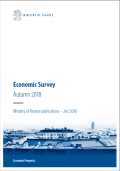Economic Survey, Autumn 2018
The year 2018 will be the peak of the current economic cycle. Finland’s economic growth will slow clearly to annual growth rates of around 1½% during the coming years. Over the medium term in 2021 and 2022, economic growth is anticipated to return to the growth rate of potential output, that is, around 1%.
Good economic and employment development and the consolidation measures taken in accordance with the Government Programme will balance public finances in the next few years. The general government budgetary position will return to surplus at the turn of the decade and the debt to GDP ratio will fall.
Finnish GDP is expected to grow by 3.0% in 2018. Business expectations are positive, construction of major building investment projects is still continuing and sales expectations in service branches have improved. The employment rate trend exceeded the cyclical peak figures seen in 2008 and is now 71.8%. Continued strong economic growth will take the number of employed persons in 2018 up 2.6% year on year. Employment growth will continue to be rapid throughout the outlook period and the employment rate will rise to 73% in 2020.
In 2019, economic growth is expected to slow to 1.7%. The biggest investment boom has now passed. The single most significant factor slowing economic growth is the contraction in construction investment. Private investment growth will continue, supported by large-scale investment projects. Growth in private consumption will be bolstered not only by the increase in the earnings level but also by the higher employment rate. Forest industry investments are already reflected in exports. The relatively low share of imported inputs in the forest industry improves the growth impact of net exports. Imports will be boosted not only by the demand for production inputs but also by domestic investment and consumption demand.
In 2020, Finnish GDP is expected to grow by 1.6%. Growth in private consumption will decelerate further, despite the sum of wages and salaries rising due to the accelerating growth in the earnings level. With inflation picking up further, real income growth will slow, however. In 2020, exports will grow to reflect export demand, but this growth will underperform world trade growth.
The increase in the earnings level will accelerate to 2.6% in 2019 due to timing factors relating to collectively agreed pay rises. In 2020, the rise of the rate of increase to 3.0% will be accelerated further by good economic growth and the re-introduction of holiday bonuses in the public sector.
- Taloudellinen katsaus, syksy 2018
(14.09.2018)
- Ekonomisk översikt, hösten 2018
(14.09.2018)

Economic Survey, Autumn 2018
14.09.2018- Publications
- Valtiovarainministeriö
- Ministry of Finance publications 24c/2018
Economic Prospects



